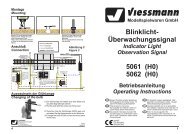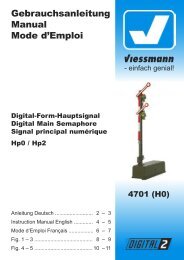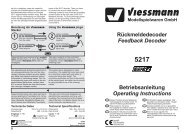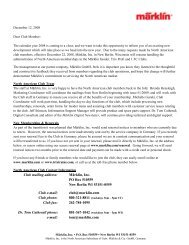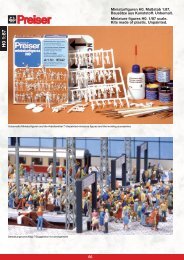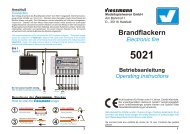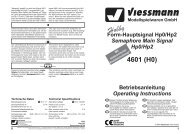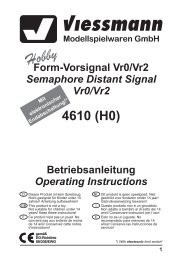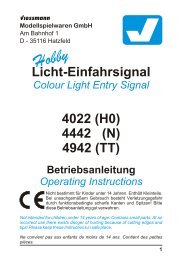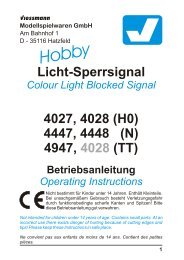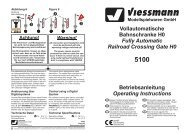Magnetartikeldecoder 5212 Betriebsanleitung DCC Digital Decoder ...
Magnetartikeldecoder 5212 Betriebsanleitung DCC Digital Decoder ...
Magnetartikeldecoder 5212 Betriebsanleitung DCC Digital Decoder ...
Sie wollen auch ein ePaper? Erhöhen Sie die Reichweite Ihrer Titel.
YUMPU macht aus Druck-PDFs automatisch weboptimierte ePaper, die Google liebt.
The decoder viessmann <strong>5212</strong> has got eight separately switchable, short circuit proof impulse<br />
outputs which can be used for example to switch semaphores, turnouts or uncoupling tracks.<br />
The decoder understands the <strong>DCC</strong> and the Motorola data format and so it can be used with the<br />
system Märklin <strong>Digital</strong>~, the old Märklin <strong>Digital</strong>=, Arnold digital new and old (controllable by the<br />
Interface, the Keyboard or the Switchboard), Lenz DIGITAL plus, Digitrax, the Uhlenbrock Intellibox<br />
and all other <strong>DCC</strong>- and Märklin-Motorola-compatible digital systems.<br />
The <strong>5212</strong> has to be set to an address, which classes it with 4 succeeding pairs of switches of a<br />
Switchboard, a Keyboard or the Intellibox. This is described in chapter “How to set the address”.<br />
Wichtig! Die Buchsen<br />
“~” immer anschließen!<br />
Important! The “~”sockets<br />
always have to<br />
be connected!<br />
~ ~ ( E)<br />
rot red<br />
E<br />
von der<br />
Zentraleinheit<br />
bzw. vom Gleis<br />
zum Trafo<br />
to a transformer<br />
()16 + V _~<br />
(-) AC/DC<br />
from the central<br />
unit resp. from<br />
the rail<br />
schwarz black<br />
Always two impulse outputs are combined to a pair (red/green). The output pairs 1 to 4 are each<br />
controlled by a push button pair of the Keyboard. A push on the green button will case an impulse<br />
at the corresponding green socket of the decoder, a push on the red button generates an<br />
impulse at the red output. The yellow socket is the common pole.<br />
A special feature of the viessmann-decoder is the possibility to supply the switching power separately<br />
at the extra sockets "~”. You have the choice to use either the digital current (see<br />
picture 1) or the current from an extra transformer (see picture 2).The second possibility relieves<br />
your digital booster and assures a reliable switching of the turnouts and semaphores,<br />
even if a lot of trains are driving simultaneously.<br />
To get the optimum of switching power you should use a DC transformer or the Viessmann<br />
Power Module 5215 for the extern power supply. This is shown on page 6. Then you must take<br />
care of the polarity (”~” = "+" = brown, “~ (E)” = "-" = red, that’s no printing error! ).<br />
Attention!<br />
If you use a separate transformer (like in picture 2) don't connect the wires “~” for the<br />
power supply to the wires of the digital current circuit.<br />
Adresse<br />
E<br />
4 3<br />
viessmann<br />
<strong>DCC</strong> -<br />
<strong>5212</strong><br />
<strong>Magnetartikeldecoder</strong><br />
J K<br />
1<br />
2<br />
But the sockets “~” always must be connected like it is shown in picture 1 and 2. If<br />
you don't do this, the decoder isn't able to generate the power impulses at its<br />
outputs.<br />
Adreßeinstellung<br />
rot red<br />
braun braun<br />
Die Adreßeinstellung erfolgt über den mit “Adresse” bezeichneten roten Drucktaster am <strong>Magnetartikeldecoder</strong>.<br />
Dazu wird der <strong>Decoder</strong> zunächst gemäß Abbildung 1 am <strong>Digital</strong>system angeschlossen.<br />
Hilfreich ist außerdem eine am Ausgang 1 angeschlossene Weiche, wie es in Abbildung<br />
1 anhand einer Trix-Weiche (Kabelfarben) exemplarisch dargestellt ist. Um nun eine<br />
<strong>DCC</strong>-Adresse zu programmieren, drücken Sie den roten Taster am <strong>Magnetartikeldecoder</strong> einmal.<br />
Die an Ausgang 1 angeschlossene Weiche schaltet langsam hin und her. Nun können Sie<br />
an Ihrem <strong>DCC</strong>-<strong>Digital</strong>system eine der Adressen senden, auf die der <strong>Decoder</strong> reagieren soll (als<br />
ob Sie einen Magnetartikel schalten wollten). Der <strong>Decoder</strong> läßt sich nur auf eine Gruppe von<br />
2<br />
3<br />
4 aufeinanderfolgenden Weichenadressen programmieren, z.B. 1 - 4, 5 - 8, 9 - 12. Es ist also<br />
nicht möglich, den <strong>Decoder</strong> auf die Adressen 3 - 6 zu programmieren, da diese Adressen 2 verschiedenen<br />
Gruppen angehören. Welche Taste innerhalb der Vierergruppe Sie bei der Programmierung<br />
drücken, ist völlig gleich. Alternativ können Sie auch einen Weichenschaltbefehl<br />
über ein Modellbahn-Steuerungsprogramm Ihres Computers (z.B. Viessmann 1011 WIN-DIGI-<br />
PET) auslösen.<br />
Hat der <strong>Decoder</strong> die Adresse akzeptiert, schaltet die an Ausgang 1 angeschlossene Weiche<br />
noch einmal langsam hin und her. Die Programmierung ist damit abgeschlossen.<br />
Drücken Sie, anstatt eine <strong>DCC</strong>-Adresse zu senden, ein zweites Mal auf den roten Taster des<br />
<strong>5212</strong>, so schaltet die an Ausgang 1 angeschlossene Weiche schnell hin und her. Nun können<br />
Sie den <strong>Decoder</strong> auf eine Motorola-Adresse programmieren. Hierzu muß der <strong>Decoder</strong><br />
natürlich an ein Motorola-kompatibles <strong>Digital</strong>system (z.B. Märklin <strong>Digital</strong> ~) angeschlossen<br />
sein und eine Motorola-Adresse ausgesendet werden. Eine erfolgreiche Programmierung wird<br />
auch hier durch ein langsames Hin- und Herschalten der angeschlossenen Weiche bestätigt.<br />
Mit einem dritten Druck auf den roten Taster des <strong>Decoder</strong>s verlassen Sie ohne Veränderung<br />
der Adresse den Adreß-Programmiermodus.<br />
Anschluß von viessmann-Formsignalen<br />
How to Connect viessmann Semaphores<br />
zum Trafo to a transformer<br />
16 V _~<br />
AC/DC<br />
4<br />
braun<br />
braun<br />
Adresse<br />
E<br />
~ ~ ( E)<br />
4 3<br />
viessmann<br />
<strong>DCC</strong> -<br />
<strong>5212</strong><br />
<strong>Magnetartikeldecoder</strong><br />
J K<br />
1<br />
2<br />
rot red<br />
braun brown<br />
rot<br />
red<br />
blau blue<br />
gelb yellow<br />
blau blue<br />
blau blue<br />
Mittelleiter - Trennstellen<br />
third rail insulations<br />
z.B. 4502<br />
und alle anderen viessmann-<br />
Formsignale mit zwei Antrieben<br />
e.g. 4502<br />
and all other viessmann sema-<br />
phores with<br />
two motors<br />
z.B. 4500<br />
und alle anderen<br />
Viessmann-Formsignale<br />
mit einem Antrieb<br />
16 V _~ (AC/DC)<br />
zum Lichttrafo<br />
to the light transformer<br />
1,5 kOhm<br />
1/4 Watt<br />
zum Gleis<br />
to the rail<br />
e.g. 4500<br />
and all other<br />
viessmann semaphores<br />
with only<br />
one motor<br />
16 V _~ (AC/DC)<br />
zum Lichttrafo<br />
to the light<br />
transformer<br />
1,5 kOhm<br />
1/4 Watt



